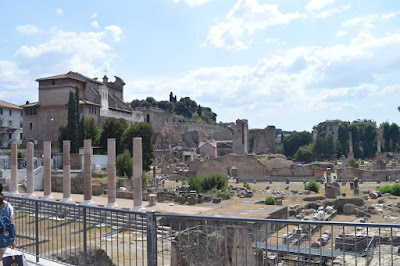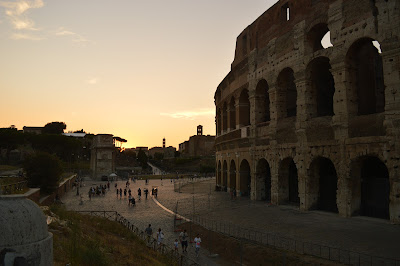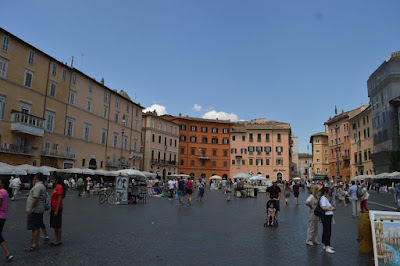“Rome is not like any other city. It’s a big museum, a living room that shall be crossed on one’s toes.” – aptly remarked by Alberto Sordi.
Rome, when one comes to talk of it, there's so much about this city. It may be a cliché, but there’s no better advice for visitors to the Eternal City than the old adage, “When in Rome, do as the Romans do.” This is where la dolce vita originated, after all.
 London? Paris? Berlin? Zurich? Maybe Brussels, center of the young union? They all strive to outdo one another culturally, architecturally, politically, fiscally. But Rome, it should be said, has not bothered to join the race for status. Rome doesn't compete. Rome just watches all the fussing and striving, completely unfazed, exuding an air like: 'Hey- do whatever you want, but I'm still Rome'.
London? Paris? Berlin? Zurich? Maybe Brussels, center of the young union? They all strive to outdo one another culturally, architecturally, politically, fiscally. But Rome, it should be said, has not bothered to join the race for status. Rome doesn't compete. Rome just watches all the fussing and striving, completely unfazed, exuding an air like: 'Hey- do whatever you want, but I'm still Rome'.
I am inspired by the regal self-assurance of this town, so grounded and rounded, so amused and monumental, knowing that she is held securely in the palm of history. Of course, after more than 2,000 years in existence, there’s enough to explore around the city and to keep one busy for years, with decadent pasta and gelato to indulge in, places to shop for haute couture, archeological sites, Baroque churches, villas-turned-museums, and enough art to overload one's senses far and wide.
Rome is the capital of Italy. Roma Provincia of Lazio region has a complete beautiful country inside it, the Vatican City, which is the House of the Pope. Vatican City, headquarters of the Roman Catholic Church, has St. Peter’s Basilica and the Vatican Museums, which house masterpieces such as Michelangelo’s Sistine Chapel frescoes. It is rightly said that one would always be in a time deficit while roaming around this city.
I would proudly quote Mark Twain here when he remarked that from the dome of St. Peter's one can see every notable object in Rome. He can see a panorama that is varied, extensive, beautiful to the eye, and more illustrious in history than any other in Europe. And it definitely stands the tests of time.
Right there I held my psyche in balance and realised that I had finally arrived to this Capital of the World, where I saw all the dreams of my youth coming to life, it has been only in Rome that it became possible for me to understand Rome.
From the Piazza di San Pietro, there was Bernini designed to look like arms extended in an embrace. In the offerings from this beautiful city are the highlights in the palace which include the Raphael Rooms, old master paintings, and antique sculptures. Just south of the Vatican City stands Castel Sant’Angelo, where popes sought solace during sieges. Climb to the top for splendid views of Vatican City and the Tiber. At its base you can see the Ponte Sant’Angelo with Bernini’s exquisitely carved marble angels.
There is so much to go around in this mesmerizing city, be it the museum of the Basilica S. Pietro, the Fountain of Trevi, Castel Snt’Angelo, the Poaltine Hill, Roman forum Arch of Titus, Altera Della Patria, Pizza Navona and the most famous Collosseum. This city has lots of offerings on the platter, with loads to see and learn from the Roman City.
The city’s mild Mediterranean climate is another persuasive draw for the visitors from the around the world. For me the main draw will always be the pulsating energy of a place which lives life as a form of theatre, and Rome had all of me at once.
If one is crazy for Italian cuisines, Italy is definitely one of the perfect place to explore the authentic Italian food. One can always hand pick a slice of pizza from any of the roadside cafes, and they would all do the justice to the taste buds. And if one has a sweet tooth, one's trip to Italy is incomplete without munching on the Italian Gelatos.
As I would narrate down my journey further, it began with my first experience with bullet train, from Pisa to Rome. The view by the train was pretty mesmerising as I could see and capture the sight of the sun setting in the mountains and the ocean, the ideal place where the sun should bid goodbye for the day.
I only had one day to cover the city of Rome, and to my luck it was Sunday so I got to be a part of the Sunday mess in the Vatican City. So my day started in the Vatican listening to the prayers and offerings by the Pope, though I could not decipher a single word as neither I knew Italian nor Spanish, but it was a great pleasure to be a part of the crowd over there. Before the crowd could disperse after the prayers, I made my way to the Vatican Museum. It was a 27 Euro ticket and a walk of around 15-20 minutes, which one would love if one is interested in the Christian culture and history.
After the Vatican I proceeded as per the map. I thought and planned of walking across the city, though I was aware that it would be a very long walk, but nevertheless being a proud wayfarer that I am, I was enjoying every corner of the city, and to no surprises it had lots of special offerings as I trailed from one point to another.
From vatican city, I proceeded towards the next stop that was the Castel Sant' Angelo, also called Hadrianeum or Sepulcrum Antoninorum, that was originally the mausoleum of the Roman emperor Hadrian and became the burial place of the Antonine emperors until Caracalla. It was built in AD 135–139 and converted into a fortress in the 5th century. It stands on the right bank of the Tiber River and guards the Ponte Sant’Angelo, one of the principal ancient Roman bridges.
It was a small walk again, to reach the top and catch the hold of the sight that this place holds. A ticket of 19 euros for the Castel was worth paying to get the view from the top.
Then, I advanced my journey to Piazza Novona, the places were pretty happening with good eating places and some beautiful fountains. The most beautiful parts of Piazza Navona are its three fountains, designed during the papacy of Gregory XIII, which are - Fontana dei Quattro Fiumi, Fontana del Moro and Fontana del Nettuno.
One can spend time there by sitting over there and enjoying the fountains.
The square is surrounded by restaurants and terraces giving Piazza Navona a lively and delightful atmosphere during the day. Here, visitors can enjoy performances by street artists like magicians and dancers. The most imposing buildings which look onto the square are the Church of Sant'Agnese in Agone and the Palazzo Pamphilj.
I did not cease to be impressed by the beautiful fountains and baroque architecture all along Piazza Navona in Rome. But there is so much more to it than meets the eye!
It is said that Emperor Domitian had the stadium built in 86 AD. It was called the “Circus Agonalis” – from the Greek “agones”, or contest. The stadium could hold up to 30,000 spectators (about half as many as the Colosseum.) It was used for all kinds of games, including nude Greek athletic contests.
From there I pressed towards the most famous fountain of Trevi. Trevi is really a marvel, the white sculpture is designed by Italian architect Nicola Salvi and completed by Giuseppe Panini, standing 26.m high and 49.15 metre wide. It is the largest baroque fountain in the city and one of the famous in the world. One would never find any other place in the world that celebrates the ever-mutating and incredible power of water like Rome. The Trevi Fountain is a fantastic work of art that is much more than a mere sculpture.
Trevi, is quite famous and is known as the wishing well. Here one has to make a wish and throw the coin into the pond and wait for one's wish to come true. Well keeping the superstitions apart, to my surprise this place does not look like what it looks in the photos. As soon as I reached the Trevi Fountain, I found myself stuck amongst hundreds of people. I guess it took me half hour to get a place to stand for myself and click the photos.
The light and shade effects on the marble make the wind seem to bellow through the drapes and locks of the statues, agitating the waves, creating an extraordinarily intense and spectacular scene. In this Baroque creation, the architecture itself seems to come alive with the current of the revitalising waters.
I wandered further towards the Piazza Venezia. There’s no way to miss the hustle and bustle of Rome’s largest round-a-bout: the Piazza Venezia. On one side you can look down Rome’s longest street, the Via del Corso to the ancient northern gates of the city. From another angle, the ruins of the Imperial Forums lead the way to the Colosseum. Take a different road and one would end up in the Jewish Ghetto, on the way to Rome’s Trastevere neighbourhood and last but not least, towering over the piazza, is the un-missable marble monument: Il Vittoriano.
 There I happened to click some pictures and moved through the Roman Forum, the Arc of Titus, the Altera Della Patria, and the Palatino Hill. It is amazing to see the Roman Architecture, the Roman pillars and all the other ruins of the ancient roman civilisation, being in the city of Rome itself.
There I happened to click some pictures and moved through the Roman Forum, the Arc of Titus, the Altera Della Patria, and the Palatino Hill. It is amazing to see the Roman Architecture, the Roman pillars and all the other ruins of the ancient roman civilisation, being in the city of Rome itself.
Architecture was central to the success of the ancient Romans. In building their great capital, they were the first people to use architecture to tackle problems of infrastructure, urban management and communication.
To do this the Romans advanced methods devised by the Etruscans and Greeks, developing construction techniques and building materials that allowed them to build on a massive and hitherto unseen scale. So solid and monumental were their structures that many great, hulking ruins remain today, thousands of years old yet dominating the centre of the modern city.
 An impressive – if rather confusing – sprawl of ruins, the Roman Forum was ancient Rome's showpiece centre, a grandiose district of temples, basilicas and vibrant public spaces. The site, which was originally an Etruscan burial ground, was first developed in the 7th century BC, growing over time to become the social, political and commercial hub of the Roman empire. Landmark sights include the Arco di Settimio Severo, the Curia and the Casa delle Vestali.
An impressive – if rather confusing – sprawl of ruins, the Roman Forum was ancient Rome's showpiece centre, a grandiose district of temples, basilicas and vibrant public spaces. The site, which was originally an Etruscan burial ground, was first developed in the 7th century BC, growing over time to become the social, political and commercial hub of the Roman empire. Landmark sights include the Arco di Settimio Severo, the Curia and the Casa delle Vestali.
After walking all through the city of Rome, finally I made my way to the most awaited destination from the city of Rome, the Colosseum, one of the great wonders of the world. I was so gripped and spellbound on seeing the Roman Colosseum. A ticket of 12 euros is what it takes to enter to the Colosseum. The Colosseum is an oval amphitheatre in the centre of the city of Rome.
The Colosseum can hold the audience of 50000 to 80000 with an average of 65000 and was built in 80 AD. It was used for gladiator contests and some other shows. It is partially ruined due to earthquakes and stone robbers, still it is the most iconic symbol of imperial Rome.
 So after a complete tour inside the Colosseum, it was almost evening and I was magnetised to the place there clicking pictures of the sunset across the Colosseum and waiting to see this monument in the night light. As it was the month of August, the daylight is there till 9 pm in the night.
So after a complete tour inside the Colosseum, it was almost evening and I was magnetised to the place there clicking pictures of the sunset across the Colosseum and waiting to see this monument in the night light. As it was the month of August, the daylight is there till 9 pm in the night.
I enjoyed road shows throughout the city of Rome, but one of the disappointed resided in me while making my way to the new city and moving to Barcelona as I could not see the night lights even after dark as well. So I returned back to the hostel, had a chit chat with room mates over there. One of them was a guy from Argentina and the other was from Spain, discussing each others travel's tales.
And there outside the hostel, my cab waited, I flew down to Barcelona for the new adventures and experiences.
It is a poem pressed into service as a city. A heady mix of haunting ruins, awe-inspiring art and vibrant street life, Italy’s hot-blooded capital is one of the world’s most romantic and inspiring cities.
See you, until next time Rome, for as Robert De Niro said Rome is Rome.
- Hardik















No comments:
Post a Comment